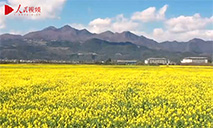Synthetic efforts to boost soybean yield, quality
HARBIN, March 24 (Xinhua) -- Chinese soybean grower Du Zhentao is buying soybean seeds and planning to double his soybean planting area.
Du in his 50s lives in Hailun, known as China's major growing area of quality soybean, in Heilongjiang Province. He plans to grow more than 20,000 mu (about 1,333 hectares) of soybean this year.
Heilongjiang, the country's leading soybean production base, has set the target of adding 10 million mu of soybean plantation area this year to boost the output. The province's soybean planting area accounts for more than 40 percent of the country's total.
Last week, the National Development and Reform Commission detailed tasks to boost agricultural production, urging vigorous efforts to expand the planting of soybean and oilseed crops to effectively stabilize and increase grain self-sufficiency rates.
Yuan Zhiquan, a farmer from Suiling County in Heilongjiang, is frequenting seed stores to select soybean seeds for spring planting these days.
"Soybean growers that I know are all planning to expand production this spring, as they are optimistic about the crop," Yuan said.
Seed companies have reported robust sales.
"Sales of soybean seeds have increased sharply this year," said Zhang Zhiting, general manager of Heilongjiang Shengfeng Seed Co., Ltd., a seed wholesaler.
The company has sold over 15,000 tonnes of soybean seeds so far this spring, already exceeding the total sales volume of last spring, and the end of the seed sales season is still more than a month away.
The city of Hailun plans to add 120,000 mu of soybean planting area this year, as farmers can benefit from the country's policies supporting the expansion of soybean planting, and profit from an expected price surge of soybean, according to Yao Hongwei, head of the Hailun municipal department of agriculture and rural affairs.
China has also launched pilots to transform paddy fields into dry land in Heilongjiang in order to divert rice to soybean planting, particularly in areas where farmers excessively rely on exploiting underground water for agricultural irrigation.
"My rice field is relatively low-lying. I pumped underground water for irrigating, and the rice output was not good. I transformed the paddy field into dry land last autumn to get it ready for growing soybean this year," said Yin Tiezhu, a farmer from Yuquan Village, Hailun, who grew 120 mu of rice last year.
Apart from the northeast part of the country, the central government has also mobilized to expand the plantation of corn and soybeans in its east, northwest and southwest regions, in efforts to ensure domestic self-sufficiency of soybean supply for making edible soybean products.
Meanwhile, efforts have been made to beef up soybean breeding to boost yield, quality, and disease resistance of the crop. Agricultural authorities in Heilongjiang have recommended 23 new soybean varieties for breeders this spring.
It is necessary for China, as the world's largest importer and consumer of soybeans, to boost farmers' enthusiasm to plant soybeans and increase soybean production capacity, which will help increase the country's self-sufficiency level for the crop and better guarantee food security, said Li Guoxiang, a researcher with the Chinese Academy of Social Sciences.
Photos
 Increasingly more young adults in China register wills that include virtual assets
Increasingly more young adults in China register wills that include virtual assets Rapeseed flowers turn NW China's Luoping into picturesque spring wonderland
Rapeseed flowers turn NW China's Luoping into picturesque spring wonderland Why do people in China fall for animated characters like LinaBell and Bing Dwen Dwen?
Why do people in China fall for animated characters like LinaBell and Bing Dwen Dwen? Photo Album: architecture in Beijing merging history and modernity
Photo Album: architecture in Beijing merging history and modernity
Related Stories
Copyright © 2022 People's Daily Online. All Rights Reserved.






